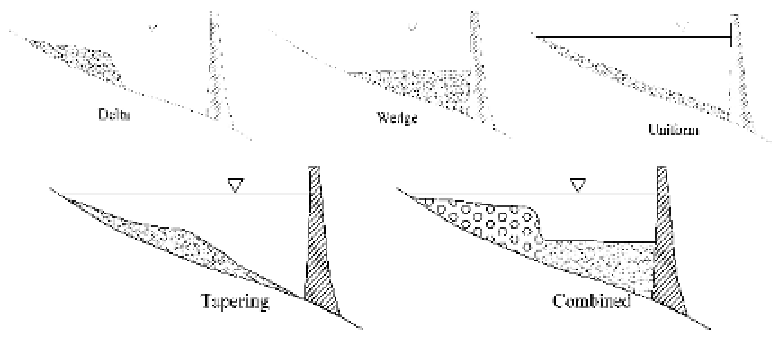Environmental Engineering Reference
In-Depth Information
Stream morphology downstream of dams can be dramatically impacted by reduction in the supply of
sediment. Clear water in the river channel, downstream of the dam tends to scour the stream bed causing
it to coarsen, degrade, and become armored. Coarsening of the bed can make it unsuitable as an ecological
habitat and spawning sites for both native and introduced species. Channel degradation can increase both
bank height and bank erosion rates
ˈ
increase scour at downstream bridges, lower water levels at intakes,
reduce navigational depth in critical locations, and lower groundwater tables in riparian areas, adversely
affecting both wetlands and agricultural areas. Sediment trapping by reservoirs reduces the suspended
solids concentration downstream, which may have many beneficial effects. The suspended solids leve1s of
many rivers have been dramatically increased due to upstream deforestation and development. Sediment
trapping in reservoirs is beneficial to aquatic ecosystems sensitive to e1evated suspended solid levels,
including coastal marine ecosystems such as grass beds and coral reefs harmed by sediment discharged
from rivers draining disturbed landscapes.
7.2.1.2
Patterns of Reservoir Sedimentation
Patterns of reservoir sedimentation depend on the operational scheme of the dam, hydrologic conditions,
sediment grain size, and reservoir geometry. In reservoirs with fluctuating water levels or that are
periodically emptied, previously deposited sediments may be extensively eroded by processes such as
downcutting by stream flow. Further complexity is added when there are significant sediment inputs
from tributaries. Most sediment is transported within reservoirs to points of deposition by three process:
(1) transport of coarse material as bed load along the topset delta deposits; (2) transport of fine sediment
in turbid density currents; and (3) transport of fine sediment as suspended load (Morris and Fan, 1998).
The longitudinal sediment deposition exhibits five basic types depending on the inflowing sediment
characteristics and reservoir operation, as shown in Fig. 7.7.
Fig. 7.7
Longitudinal patterns of sediment deposition in a reservoir
Delta—
A delta shaped deposit is formed with the coarse fraction of the sediment load, which is
rapidly deposited at the upper zone of the reservoir. It may consist of coarse sediment or may also contain a
fraction of finer sediment such as silt. Such a deposition pattern occurs if the reservoir remains at high
pool level for a long time.
Wedge—
A wedge shaped deposit is a typical pattern of fine sediment deposition by turbidity currents.
It occurs in small reservoirs with a large inflow of fine sediment and in large reservoirs operated at a low
pool level during flood events, which causes most sediment to be carried to the vicinity of the dam.
Figure 7.8 shows the profile of the Bajiazui Reservoir on the Puhe River as an example of the wedge
shaped deposit.


Search WWH ::

Custom Search